BalticLitter (RFBR 18-55-76001) ERA.Net RUS Plus Call 2017 – Science & Technology
Litter rim of the Baltic Sea coast: monitoring, impact, and remediation.
Coordinator: Dr. Sci. Irina Chubarenko (Russian Federation, P.P. Shirshov Institute of Oceanology of Russian Academy of Sciences (SIO))
Project partners:
- Prof. Dr. habil. Gerald Schernewski (Germany, Leibniz-Institute for Baltic Sea Research (IOW))
- Dr. Georg Martin (Estonia, Estonian Marine Institute, University of Tartu (EMI))
Project webpages:
http://www.sea.ee/balticlitter/
Annotation: Micro-, meso-, and macro-litter along the Russian, Estonian, and German marine beaches will be monitored using the unified methodology, which will also be tested on the coasts lagoons, estuaries, and river mouths of the partner countries. Migrations of marine litter between the beach and underwater slope will be investigated, with emphasis on observations of massive litter beaching after stormy events. Link between marine litter and human pathogens will be examined. An impact of presence and migrations of litter in sea coastal zone on benthic ecosystems in coastal marine environment will be investigated in microcosm experiments. Numerical modeling will be applied to relate the amount and distribution of the beached litter to hydrophysical and meteorological conditions, allowing for the development of a new monitoring methods and a strategy for more effective cleaning of the sea coastal zone. The expected results include (i) implementation of the unified methods of the beach litter monitoring on the marine coasts of the three partner countries; (ii) results of testing of this methodology for coasts of lagoons and river mouths/estuaries, with development of specific recommendations; (iii) joint data base for the amount, distribution, and composition of the beach litter for all the monitored coasts; (iv) observational evidence and modeling substantiation of the linkage between external physical forcings and amount and composition of the beached litter; (v) development of physically-based strategy for cleaning of the coasts after stormy events; (vi) results of investigation of functioning of microbial biofilms on different sorts of plastic, disclosing the relationship between litter and human-pathogens; (vii) results of mesocosms experiments on effects of marine meso and macrolitter on benthic ecosystem; (viii) dissemination of the results via scientific publications, developed highschool teaching course, and public beach-cleaning campaigns in the partner countries.
Results and activities:
- 2018. In 2018, the Russian project team has begun monitoring of the marine anthropogenic litter on the open sea coasts of the Kaliningrad Region and the Gulf of Finland for the first time using methods developed for the Baltic Sea sandy beaches and implemented earlier on the German, Polish and Lithuanian coasts. A joint effort of the project partners was made to analyze the experience in assessing the pollution of the inland water bodies’ shores; consequently, an appropriate monitoring method was proposed and tested on 22 sites on the coast of the Vistula Bay, the Curonian Bay, and the Neva Bay. The advantage of the chosen technique is that it allows comparing the contamination of the open and inner banks with large micro- (2-5 mm), meso- (5-25 mm) and macro-debris (> 25 mm). According to the first field data, the concentration of anthropogenic marine debris is significantly higher on the inner coasts, especially concerning the fractions of meso- and macro-debris. For the first time, a methodology for monitoring storm emissions of anthropogenic marine debris was proposed and started being tested on the open sea coasts of the Kaliningrad Region. A comparative analysis of the marine debris pollution on the city beaches (Klaipeda, Zelenogradsk) and the beaches of the Curonian Spit National Park has been carried out; it was concluded that the concentration of microplastic particles < 2 mm in the sand on the edge of the beach gives an estimate of the background pollution of this water area (including the coastal submerged slope), while the distribution of larger particles is spotted and depends on the local environmental conditions and anthropogenic load. Grids were prepared and data collection started for numerical simulation of storm situations. Parameterization options for fragmentation of various plastic types (LDPE, PS, PP, foamed PS) in the surf zone were proposed.

Monitoring sites at the Curonian spit
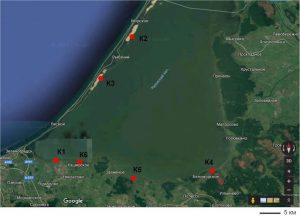
Monitoring sites at the coast of Curonian lagoon
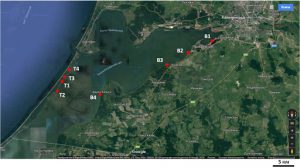
Monitoring sites at the coast of Vistula lagoon
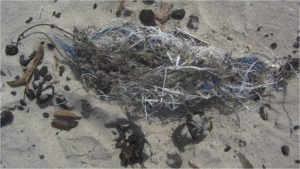
Litter at the Curonian Spit
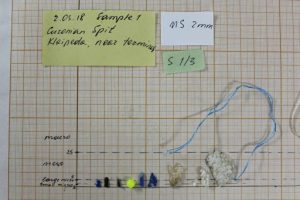
Sand Rake sample analysis

Lagoon monitoring with the “Marine litter sampling method”
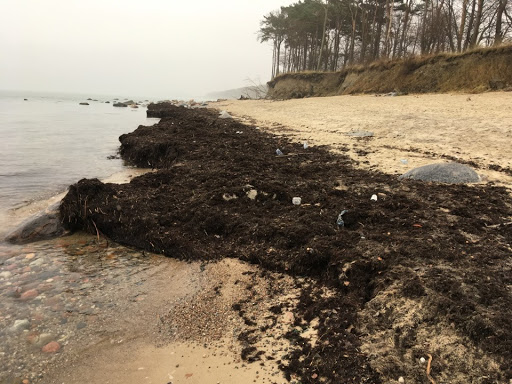
Massive littering events after the storm – a lot of algae and litter, including plastic pieces, are washed ashore (Kaliningrad region coast)
- 2019. During the reported period, the Russian scientific team continued quantification and examination of the distribution of marine anthropogenic debris on the open-sea and inland coasts using common with the partners sampling methods (Sambian Peninsula: two monitoring expeditions – to the western and northern coasts, seven expeditions to evaluate the amount of anthropogenic marine litter washouts after a storm; Neva Bay: assessment of contamination of 7 beaches). An analysis of the pollution of the beaches of the Curonian Spit National Park by anthropogenic litter of various size fractions allowed proposing a scientifically-based indicator of the level of plastic contamination – the number of plastic particles in the size range of 0.5-5 mm per 1 kg of sand sampled in the zone of wave run-up. This parameter turned out to be unchanged over 100 km-long coastline, including the territory of the National Park and two city beaches at its borders, which allows it to be used both to monitor an increase in pollution levels in this region over time, as well as to compare contamination levels in different regions. To verify this result, an expedition was carried out with sampling on the coast of the National Park of the partner country – Germany. Together with foreign colleagues, a methodology is being developed for identifying possible sources of beach contamination with anthropogenic litter. Recommendations on the modification of methods for specific types of coasts of inland coastal waters are proposed. The data collected are organized in the form of a common database accessible to all project participants; it currently contains 1803 storage units. In order to propose the most effective scheme for cleaning beaches from anthropogenic debris, an analysis is made of the physical mechanisms responsible for the washouts of marine litter on the coast. A numerical simulation of the propagation of microplastic particles released from the Neva river, in the Neva Bay and in the eastern part of the Gulf of Finland was carried out using a three-dimensional numerical hydrodynamic model based on the Princeton Ocean Model (POM). Information on 240 cases of significant marine litter washouts to the coast of the Kaliningrad Region (2011-2019) was collected and systematized on dates, places, history of variations of meteorological parameters and wave characteristics, with the aim of further analysis using an artificial neural network. The analysis will allow for prediction of the location and time of significant marine litter washouts, based on publicly available data on the development of the particular storm-case.
